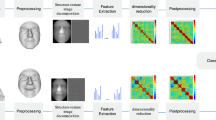Abstract
Crest lines, curves on a surface along which the surface bends sharply, are powerful shape descriptors. Crest lines and their subsets have numerous applications in image analysis, face recognition, analysis and registration of anatomical structures, surface segmentation and non-photorealistic rendering. In this paper, a method is proposed for robust detection of crest lines. The proposed method is based on contextual information, the attributes of neighboring points. So it provides a basis of robustly detecting salient crest lines corresponding to potentially important features. Consequently, the algorithm is immune to noisy mesh and textured mesh with repeated bumps. Comparative results indicate that our algorithm yields favorable detection results and is effective.
Similar content being viewed by others
References
Agam, G., Tang, X.: A sampling framework for accurate curvature estimation in discrete surfaces. IEEE Trans. Vis. Comput. Graph. 11(5), 573–582 (2005)
Belyaev, A., Anoshkina, E.: Detection of surface creases in range data. In: Eleventh IMA Conference on the Mathematics of Surface’05, pp. 50–61. Springer, Berlin (2005)
Belyaev, A., Ohtake, Y.: An image processing approach to detection of ridges and ravines on polygonal surfaces. In: Proc. of Eurographics’00, pp. 19–28. Interlaken, Switzerland (2000)
Cazals, F., Pouget, M.: Estimating differential quantities using polynomial fitting of osculating jets. In: Proc. Symposium on Geometry Processing’03, pp. 177–187. Elsevier Science Publishers B.V., Amsterdam, The Netherlands (2003)
Chen, K.: Adaptive smoothing via contextual and local discontinuities. IEEE Trans. Pattern Anal. Mach. Intell. 27(10), 1552–1567 (2005)
Chen, X., Schmitt, F.: Intrinsic surface properties from surface triangulation. In: Proc. Eur. Conf. Computer Vision’92, pp. 739–743. Springer, London (1992)
Decarlo, D., Finkelstein, A., Rusinkiewicz, S., Santella, A.: Suggestive contours for conveying shape. ACM Trans. Graph. 22(3), 848–855 (2003)
Eberly, D., Gardner, R., Morse, D., Pizer, S., Scharlach, C.: Ridges for image analysis. J. Math. Imaging Vis. 4(4), 353–373 (1994)
Goldfeather, J., Interrante, V.: A novel cubic-order algorithm for approximating principal direction vectors. ACM Trans. Graph. 23(1), 45–63 (2004)
Grenader, U., Miller, M.I.: Computational anatomy: An emerging discipline. Q. Appl. Math. 56(4), 617–694 (1998)
Gumhold, S., Wang, X., Mcleod, R.: Feature extraction from point clouds. In: Proc. 10th International Meshing Roundtable’01, pp. 293–305. Sandia National Laboratories, Newport Beach, CA (2001)
Hallinan, G.G.G., Yuille, A.L., Giglin, P., Mumford, D.: Two- and Tree-Dimensional Patterns of the Face. A.K. Peters, Ltd., Natick, MA (1999)
Hameiri, E., Shimshoni, H.: Estimating the principal curvatures and the Darboux frame from real 3-D range data. IEEE Trans. Syst. Man Cybern. 33(4), 626–637 (2003)
Interrante, V., Fuchs, H., Pizer, S.: Enhancing transparent skin surfaces with ridge and ralley lines. In: Proc. IEEE Visualization’95, pp. 52–59. IEEE Computer Society, Washington, DC (1995)
Lee, C.H., Varshney, A., Jacobs, D.W.: Mesh saliency. In: Proceedings of ACM Siggraph’05, pp. 659–666. ACM, New York, NY (2005)
Lengagne, R., Fua, P., Monga, O.: Using crest lines to guide surface reconstruction from stereo. In: Proc. of International Conference on Pattern Recognition’96, pp. 9–13. Vienna, Austria (1996)
Lopez, L.F., Serrat, J.: Creaseness from level set extrinsic curvature. In: Proc. ECCV’98, pp. 156–169. Springer, Berlin, Heidelberg (1998)
Lukacs, G., Andor, L.: Computing natural division lines on free-form surfaces based on measured data. In: Mathematical Methods for Curves and Surfaces II’98, pp. 319–326. Vanderbilt University, Nashville, TN (1998)
Meyer, M., Desbrun, M., Schroder, P., Barr, A.H.: Discrete differential-geometry operators for triangulated 2-manifolds. In: Visualization and Mathematics III’03, pp. 35–57. Berlin (2003)
Monga, O., Armande, N., Montesinos, P.: Thin nets and crest lines: Application to satellite data and medical images. Comput. Vis. Image Underst. 67(3), 285–295 (1997)
Ohtake, Y., Belyaev, A., Seidel, H.-P.: Ridge-valley lines on meshes via implicit surface fitting. ACM Trans. Graph. 23(3), 609–612 (2004)
Pauly, M., Keiser, R., Gross, M.: Multi-scale feature extraction on point-sampled models. Comput. Graph. Forum 22(3), 281–289 (2003)
Stylianou, G.: A feature based method for rigid registration of anatomical surfaces. In: Geometric Modeling for Scientific Visualization’03, pp. 139–152. Springer (2003)
Stylianou, G., Farin, G.: Crest lines for surface segmentation and flattening. IEEE Trans. Vis. Comput. Graphics 10(5), 536–543 (2004)
Sylvain, P., Loria, C., Inria, L.: A survey of methods for recovering quadrics in triangle meshes. ACM Comput. Surv. 34(2), 211–262 (2002)
Taubin, G.: Estimating the tensor of curvature of a surface from a polyhedral approximation. In: Proceedings of Fifth International Conference on Computer Vision’95, pp. 902–907. IEEE Computer Society, Washington, DC (1995)
Thirion, J.-P.: The Extremal Mesh and the Understanding of 3D Surfaces. Technique report (1993)
Tong, W.-S., Tang, C.-K.: Robust estimation of adaptive tensors of curvature by tensor voting. IEEE Trans. Pattern Anal. Mach. Intell. 27(3), 434–449 (2005)
Yoshizawa, S., Belyaev, A., Seidel, H.-P.: Fast and robust detection of crest lines on meshes. In: Symposium on Solid and Physical Modeling’05, pp. 227–232. ACM, New York, NY (2005)
Author information
Authors and Affiliations
Corresponding author
Rights and permissions
About this article
Cite this article
Zhihong, M., Guo, C. & Mingxi, Z. Robust detection of perceptually salient features on 3D meshes. Vis Comput 25, 289–295 (2009). https://doi.org/10.1007/s00371-008-0268-2
Published:
Issue Date:
DOI: https://doi.org/10.1007/s00371-008-0268-2




